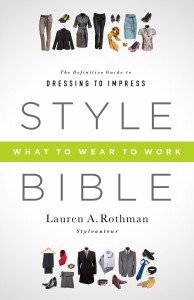This morning, you were stylin’.
You left for work, in fact, feeling like a million bucks in your favorite shirt, your most comfortable suit, and your lucky undies. Yessir, it would be a good day – and it might be even better if you didn’t have missing buttons, a stain on your suit, and undies that played peek-a-boo.
Nobody at work dresses like you do… for a reason. In the new book “Style Bible” by Lauren A. Rothman, you’ll learn how your workplace wardrobe may be holding your career hostage.
One of the first important decisions you faced this morning was made when you rifled through your closet and got dressed. But what do the clothes you wear to work say about you? Do they tell the world you’re put-together or slapped-together? Professional or probationary? Well-regarded or well-worn?
That’s important to know, since first impressions are “formed in less than five seconds,” says Rothman. That’s about how long it takes for “an eye roll,” which is not desirable when you’re trying to impress a prospective employer or client. The good news is, you can look great at any stage of your career without busting the budget.
To begin, identify your personal style. That’s the “most challenging” thing, says Rothman, but understanding is necessary so you know where to start. Also, know the dress code for your workplace, which may vary from industry to industry.
For the professional woman, there are seven “basics” you’ll need to have, whether you purchase them or shop your closet: “the third piece,” suits, pants, skirts, tops, dresses, and coats. Look for a good fit, some trendiness without faddishness, a good length and good coverage, and accessories that “make” the outfit.
Basics for men are a little easier: shirts, pants, suiting, and outerwear, including sweaters. Don’t be afraid to go with a little color here, advises Rothman. Do be aware of wearing the wrong item in any of these categories. And if you have a closet full of pleated pants, “run home and throw them out.”
Know office-fashion dos and don’ts. Watch how you accessorize. Don’t forget skin care and hygiene. Use a full-length mirror before you leave the house. Watch for “skin belts,” peek-a-boo underwear, and cleavage. And remember: “just because it zips doesn’t mean it fits.”
When I first picked up “Style Bible,” I figured it was just for college grads and workplace newbies. Otherwise, who doesn’t understand how to dress for success?
Then I started to think of all the Style Don’ts I know, and that made me a new convert to this book. Indeed, author Lauren A. Rothman makes it pretty simple to get your style on without making too many errors. She offers advice from the POV of an expert, but she keeps it light without beating readers over the head with mandates.
This book may not be the cure-all that some professionals could need, but it’s a great start. If you’re stymied by style or have no real feel for fashion, “Style Bible” will suit you just fine.





